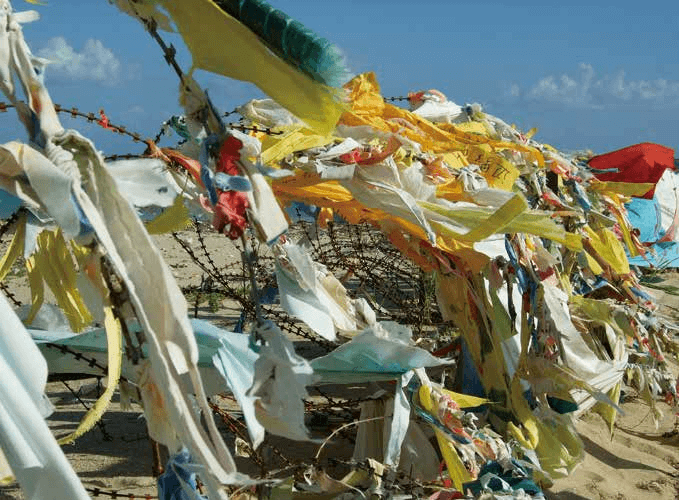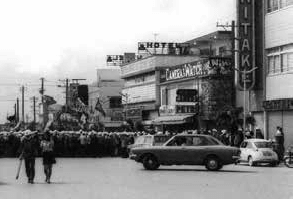Issue:

CAUGHT BETWEEN BEING IGNORED AND BEING OCCUPIED: THE UNDER-REPORTING OF OKINAWA
What happens in Okinawa . . .
by Jon Mitchell
In September 2012, Okinawa residents succeeded in doing what the governments of the U.S. and Japan have been promising since 1996: they closed the Marine base at Futenma. For 22 hours, protesters blocked the main gates of the base, preventing anyone from entering or leaving, and it was only after Japanese police had dragged away and illegally detained more than 100 people including two members of the National Diet that Futenma was finally reopened.
This was the first time that the installation had been shut down since Okinawa’s reversion to Japan in 1972, but you’ll be forgiven if you’ve never heard about this small slice of history. Although the story topped the island’s nightly news and made the headlines of its two daily newspapers Okinawa Times and Ryukyu Shimpo the national media chose to ignore it.
Such treatment is typical of the main land press, which consistently turns a blind eye to the iniquities suffered by residents of Japan’s poorest and most militarized prefecture. Take the August 2004 crash of a U.S. military helicopter on the campus of Okinawa International University; the Japanese mainstream media barely broke from its coverage of the opening of the Athens Olympic games. More recently, it has neglected the Japanese government’s SLAPP (strategic law suit against public participation) action versus residents blocking the construction of Osprey helipads in the northern Okinawan jungles. If Tokyo is victorious in this case, it will set a precedent for future suppression of civil disobedience throughout Japan.
True, there have been gaps in the media’s wall of silence the 1995 gang rape of a schoolgirl and the 100,000 person anti Osprey protest in September 2012 spring to mind but these are exceptions. The island has always been a place where the governments of the U.S. and Japan have done things that they couldn’t get away with elsewhere. And, all too often, these injustices have been allowed to pass unreported and unchallenged.
Tomo Yara, a former Okinawa Times journalist who has been covering U.S. base issues for 21 years, blames this failure on two main reasons.
“Mainland journalists depend too much on Japanese government sources who themselves know very little about military issues in Okinawa. For example, they don’t even know the precise num ber of U.S. Marines actually stationed on the island. Secondly, the Japanese correspondents in Washington are very well controlled by the U.S. government’s Japan handlers all of whom say that the only reason U.S. bases are needed in Okinawa is to protect the island and Japan.”
A refusal to subscribe to this myth that military bases are necessary for the security of the island divides many Okinawa journalists from their mainland counterparts. Okinawa was the only Japanese prefecture to be invaded during World War II and the slaughter of more than a quarter of its population taught islanders that military bases never protect civilians, they merely make them more of a target.
A HISTORY OF PRESS MANIPULATION
These firsthand experiences of the Battle of Okinawa shaped the attitude of many Okinawan journalists in the 1950s who brought to their reportage a distrust of not only the U.S. military but any military. In the early days of the Cold War, while the Pentagon transformed their island into its much heralded “Keystone of the Pacific,” these journalists covered the seizure by bulldozer and bayonet of farmers’ land a history little remembered on the mainland today. Throughout the 1960s, the same reporters chronicled the rapes, assaults and murders in Okinawa committed by traumatized American troops on R&R from the jungles of Vietnam.
In chasing down these stories, some Okinawa journalists allied themselves with members of the American antiwar groups that formed within the bases. These GI’s tipped off reporters with inside information related to military accidents and secret B-52 bombing runs to Southeast Asia.
While the U.S. authorities did not explicitly censor the Okinawa media at the time, they had other ways to control the island’s journalists. If officials were unhappy with reporters, their press cards were suspended, which prevented them from attending briefings. When stories were published that revealed particularly sensitive information, Okinawa journalists faced sustained grilling to make them give up their sources.
The Pentagon found hampering international journalists’ attempts to report on the island far easier, since it could control access to the island. Correspondents whose visits were green lit found themselves shuttled from well manicured bases to meetings with pro U.S. friendship societies on micro managed junkets overseen by a military guide. Despite many U.S. journalists’ critical stance towards the war in Southeast Asia, they wrote very few articles about the problems that occurred on the forward staging post for the conflict Okinawa.
Throughout the ’50s and early ’60s, most Japanese journalists showed little sympathy for Okinawa. However, as U.S. plans to return the island to Japan became known, overnight more Japanese reporters developed an interest. At official press conferences, these new arrivals frustrated local journalists by hogging question time with enquiries about reversion rather than the more explosive issues of the 1969 leak of nerve gas near Kadena Air Base and the post eversion fate of the island’s nuclear arsenal.
The investigative skills that many Okinawan journalists had honed during the 27-year U.S. occupation put them in good stead for the period after 1972, and the next generation of reporters inherited their seniors’ expertise. When U.S. military personnel cordoned off the site of the 2004 helicopter crash at Okinawa International University, for example, one young Okinawa TV reporter attempted to break through the barricades, lambasting the MP’s for their flagrant abuse of extra territoriality. It’s difficult to envisage a similar display from mainland journalists firmly tethered to their networks.

Despite or perhaps because of its neglect of Okinawa issues, the mainland community often recognizes the cojones of its island peers. Both Okinawa dailies have won awards from the Japan Congress of Journalists and the Japan Shimbun Rouren. Likewise, TV documentaries produced by Okinawa local networks regularly receive national acclaim.
IGNORANCE AND REPERCUSSIONS
Which brings me to my own interest in the gap between Okinawa and Japan’s mainland media. In November 2012, Defoliated Island, a Ryukyu Asahi Broadcasting documentary based upon my investigations into the usage of Agent Orange in Okinawa during the Vietnam War, picked up a commendation for excellence and was short listed for a broadcast culture award from Japan’s Association of Commercial Broad casters. For the past two years, my articles for The Japan Times on the legacy of chemical weapons in Okinawa have been regularly followed up by Okinawa’s media. But the mainstream has roundly ignored them even when I reported allegations that hundreds of barrels of Agent Orange were still buried beneath a strip of Okinawa’s prime tourist turf.
Breaking stories such as these, and then watching as they sank without trace, not only rankled my pride but also brought home the extent to which Okinawa is treated as a foreign country. If those barrels of dioxin leaking poisons had been buried beneath Tokyo’s Odaiba, for instance, the media (in particular Fuji TV, whose studios are located there) would likely have been up in arms. However, it seems that what happens in Okinawa stays in Okinawa.
The root of this ignorance seems to lie in an over reliance on official sources and the belief that the suffering of Okinawa’s residents is a small sacrifice against the fictional security that military occupation offers Japan from Chinese aggression. In addition there is also an element of condescension towards the island’s grassroots civil disobedience movements an elitism also evident in the failure to report on Tokyo’s weekly anti-nuclear demonstrations.
At the award ceremony for Defoliated Island last November, I received a glimpse of one more possible explanation. A reporter from one of the mainland networks approached me and, after the obligatory congratulations, asked if I worried about repercussions from my writing about Okinawa. I reminded him that freedom of the press was protected in Japan and he nodded politely. But before he walked away, he told me to remember Takichi Nishiyama, the Mainichi Shimbun journalist whose reporting of monies paid by Tokyo to the U.S. for Okinawa’s reversion had resulted in his reputation being destroyed by the powers that be.
Although Nishiyama’s allegations have long since been vindicated, the fact that his name is still invoked with such wariness suggests just how deep his humiliation had resonated. The Japanese government had meant his persecution to send a signal to others meddling in its affairs, and it had worked. It was a lesson to the rest of the media of the personal and professional risks involved in writing critically about an island still 20 percent under Pentagon control an island where Washington and Tokyo still feel entitled to trample with impunity on the rights of 1.4 million people.
Jon Mitchell is an Asiwrites regularly about Okinawa for The Japan Times. a-Pacific Journal associate who

